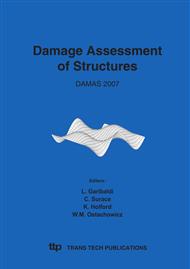p.205
p.213
p.221
p.227
p.233
p.239
p.245
p.253
p.259
Near Real-Time Monitoring of Bead Area Damage in Rolling Tires Using a Rotating Wheel Model and Multi-Directional Vibration Data
Abstract:
In current tire durability tests, technicians must stop tests periodically to inspect each tire, resulting in a time consuming, expensive, and relatively subjective process. Online tire monitoring would thus be a dramatic improvement over the current methodology. If such a system could be extended to on-line vehicle use, it could dramatically increase safety, reduce downtime, and lead to better fuel efficiency in commercial and passenger cars and trucks. A near real-time system to monitor the initiation of bead area damage in rolling tires was developed using vibration data collected from the wheel end spindle. To generate an accurate model of the forced response of the wheel end spindle, a tire on a fixed spindle was impacted with a modal punch while the tire was preloaded against a plate. The frequency response functions acquired from this system were then used to develop a rotating tire model consisting of time-delayed forcing functions applied to the tire patch at the rolling frequency; this model was used to assist in interpreting the results from the near real-time monitoring system. The near real-time continuous monitoring system has been deployed in a manufacturing test environment and utilizes frequency data from three mutually orthogonal acceleration measurements. These data are combined to create a highly sensitive composite index that identifies when the initiation of bead area damage has occurred.
Info:
Periodical:
Pages:
233-238
Citation:
Online since:
September 2007
Authors:
Keywords:
Price:
Сopyright:
© 2007 Trans Tech Publications Ltd. All Rights Reserved
Share:
Citation:


